Don’t Struggle with Rivals—Leverage Them With Comarketing
Published on January 15, 2016/Last edited on January 15, 2016/7 min read


Team Braze
You know who your biggest competition is. You can be found alternatively shaking your fist at them and admiring them. Maybe you resent them. Maybe they inspire you! Maybe both at the same time.
Whoever they are, the reality is your Twitter followers might follow them, too. Your newsletter subscribers might also subscribe to theirs. Your marketing efforts might fall on the same eyes and ears. You want their audience, and if you’re doing things right, they want yours.
Traditional logic encourages you to set out to beat them. To steer clear of them in the marketplace. To focus on doing whatever it is you do, but better.
But what if both you, your customers, and yes, maybe even that other brand, can all come out ahead with a bit of cooperation? Read on for the hows and whys of partnering with a comarketing or coopetition strategy, plus a look at how Dan Savage, Amazon, and Tap for Tap get it right.
Practical reasons to partner
Benefit from Google’s preference for friendliness
When you partner with a brand in your same vertical, part of what you’re after is a good amount of digital cross-reference. They point to you, and you point to them.
Google ranks mobile content just as it ranks web content. An app’s content can show up in search results, even if that app doesn’t have matching web content, and even if that app isn’t installed on a certain device. Google values a sociable web, and weighs web search results, in part, based on who has the most high-value links pointing to them.
In a partnership, you’ll benefit from the direct traffic and the long-term SEO value.
Learn from your rivals’ mistakes and successes
If you have a nominal competitor willing to partner with you, you’ll both be able to learn from each other. What do they do well? What are some of their big misses? In a partnership, you’re bound to glean insights you can use to strengthen your own process.
Combine forces to open a new segment of the market
Perhaps you and your adversary have mutually beneficial technologies, or access to potentially reciprocal resources. By teaming up, you may lead the way to new opportunities in your industry, for both of you and those who follow!
Become a reliable backup & reserve a reliable backup
Present your collaboration as a way to fill in the pieces the competition may be missing in their own organizational structure. Or position yourself as their reliable backup when they have a surplus of work. In that way, you might likewise be reserving a go-to firm for when you find yourself in the happy position of having more work than your team can handle.
3 ways to partner with your competition
Martin Zwilling, tech professional, angel investor, and veteran startup mentor, says strategic partnerships “can take the form of joint ventures, intellectual-property licensing, outsourcing agreements or even cooperative research. All of these offer the potential for a win-win relationship with a nominal competitor.”
He cautions that deals like this can work beautifully, “as long as both sides can remain humble and not try to dominate the relationship.” Here are some ideas:
- Content like a joint newsletter or guest blogging on each other’s sites: This one is the simplest, and could be a harbinger for future collaborations. Invite a competitor whom you genuinely respect to write a post on your blog, or a blurb in your newsletter, in exchange for the opportunity to do the same for them.
- Co-produce an event: Events build community, and could establish your reputation as a collaborator or even a mentor in your field.
- Exchange ad space or do a “product add-on”: Your ad goes on their site, their ad goes on your site, for mutual brand promotion. (This works especially well in cases where you and a competitor both sell the same or similar products.) With a product add-on, when a customer puts an item in their cart, they might get a deal or suggestion to buy a similar or related item from the competitor.
Examples of competitors teaming up to mutual benefit
The Savage Lovecast: co-market with a well-aligned partner
Cooperation: Dan Savage routinely hosts his competitors as guests (some NSFW language there) on his own sex and love advice podcast. In April 2015, one such event was billed as the opportunity to,“witness Dan vs. the mighty Cheryl Strayed from the Dear Sugar podcast in an ADVICE SLINGING CLASH OF THE TITANS.”
Why it worked: This collaboration allowed Savage to introduce his listeners to Strayed, and likewise drew her users to his event. Rather than worry that they might lose part of their own listener base to their competitor, they were each confident enough in their own advice-giving to take the risk.
Savage and Strayed chose to add value for the customer by exposing their loyal listeners to a competitor, ultimately broadening their listeners’ awareness, and providing more abundance in the niche. It evidently worked well for them, too, as Dan Savage has agreed to visit Cheryl Strayed’s podcast in return.
Proceed with caution: This approach works well when user bases overlap, but aren’t mutually exclusive. A listener can have to two sex/love advice podcasts in their life, but a B2B client can only use one email marketing software. This type of team-up works well for competition that’s slightly indirect.
Amazon’s 3rd party sellers: invite rivals into the business model
Cooperation: Amazon was, at first, a bookseller. It later became the general store we’re familiar with. In 2000, it introduced Amazon Marketplace, a feature that at the time felt tantamount to a local shop owner inviting other store owners in to set up kiosks selling exactly the same merchandise alongside their own. Business journalist Matt Palmquist describes the move as, “an unconventional strategy that seems purely counterintuitive.”
Why it worked: Palmquist tells us what others can learn from the Amazon approach: “The first lesson, although it flies in the face of traditional thinking, is to let the competitor win—for a little while, at least. By inviting rivals into its business model and thus creating a larger overall market, a firm can potentially capture a bigger share for itself down the road.”
We all know and love the convenience and simplicity of Amazon’s experience, and appreciate being able to compare prices on items from multiple sellers at once. This value to the customer has helped make Amazon the e-tailer giant we know today, and is the reward that paid for the risk.
Proceed with caution: Amazon is Amazon. They hit it big on a model that worked for them, but Amazon plays by different rules, largely because of their scale.
Tap for Tap’s Tap Exchange platform: cross promote and share traffic
Cooperation: Tap for Tap is a mobile app ad exchange network popular with game developers. Their Tap Exchange platform allows developers to cross-promote and share traffic with one another by placing ads in one another’s apps and games.
Why it works: Their credo is, “Give taps to other developers, and other developers will give taps back to you, simple as that.” They’re banking on the fact that giving taps doesn’t mean “giving taps up.” They’re building on the theory that more awareness for the consumer creates an abundance of interest. Consumers are introduced to more apps they’ll love, which in turn keeps them using apps within the Exchange.
Proceed with caution: Traffic exchanges should be approached with an editorial eye. Surfacing your links to users on an app or brand that doesn’t align well with your market won’t send you any worthwhile traffic. And hosting links on your owned channels to brands that don’t speak to your customers can make you seem out of touch.
Serving the user, in the end, serves you
Amazon brought the consumer convenience and variety. Dan Savage and Cheryl Strayed partnered to provide their listeners with more information and an extra-exciting podcast. Through the Tap Exchange, customers are offered ease of use, exposure to more apps and experiences they like, and sometimes deals and savings.
Bring more value to your customer—even if that value comes in the form of competitor involvement—and the customer will reward you with their continued engagement.
Be Absolutely Engaging.™
Sign up for regular updates from Braze.
Related Content
View the Blog
Look out: Outlook's new email requirements and what they mean for Braze senders

Alison Gootee

How the Braze Data Platform enhances flexibility and fosters collaboration

Sahiz Kaur

Customer churn prediction: Using data for smarter retention
